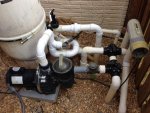I have the timer set up on my 2 speed pump so that it only runs at high speed for about 8 hours. The rest of the time it's on the low speed setting. I've noticed that after it kicks down to low, the first inlet in line (there are 3 main and 1 for the aux pump) starts to bubble all the time. There are no bubbles showing when at high speed.
The bubbling doesn't start right away. It usually takes about 5 to 10 minutes. Since I have a SWG, I would expect it to do some bubbling whenever it cycles on. In my case, the bubbles don't stop unless I bleed air using the valve on top of DE tank.
Once I bleed the air, it will bubble when the SWG is active. After about 10 minutes or so, it'll start to bubble continuously again regardless of the SWG until I bleed the valve again.
I have 2 skimmers and a main drain. I've tried to play with the directional valve settings to see if I got any different results, but it all seems to end up with the same thing.
I've had someone check the system for leaks. He pressure tested the lines and didn't find any leaks there. He tightened down and resealed the fittings at the directional valves, pot, impeller and tank. He also replaced the pot cap o-ring since I had noticed that when it kicked down to low it would spit out a little bit of water from the top of the pot. All of this to no avail. Whenever it goes to low speed, I get a small bubble that forms in the pot and stays there (the water in pot lowers about an inch) and, after a few minutes, I get the bubbles coming out of the first inlet.
The person that did the work is blaming it on the fact that the pool equipment is higher than the pool (about 6-7 feet following the slope of the yard) and he claims that no matter what I do, I'm always going to have the low speed bubbling issue since it's got to work that much harder to pull the water uphill and can't prevent cavitation (almost his exact words).
Is what he's telling me in fact true? Since it helps to bleed the air out form the DE tank, is there some way to automate that?
I don't really want to go back to having the pump on high all the time and I'd rather have it on low than completely turn it off.
Thanks in advance for any feedback.
The bubbling doesn't start right away. It usually takes about 5 to 10 minutes. Since I have a SWG, I would expect it to do some bubbling whenever it cycles on. In my case, the bubbles don't stop unless I bleed air using the valve on top of DE tank.
Once I bleed the air, it will bubble when the SWG is active. After about 10 minutes or so, it'll start to bubble continuously again regardless of the SWG until I bleed the valve again.
I have 2 skimmers and a main drain. I've tried to play with the directional valve settings to see if I got any different results, but it all seems to end up with the same thing.
I've had someone check the system for leaks. He pressure tested the lines and didn't find any leaks there. He tightened down and resealed the fittings at the directional valves, pot, impeller and tank. He also replaced the pot cap o-ring since I had noticed that when it kicked down to low it would spit out a little bit of water from the top of the pot. All of this to no avail. Whenever it goes to low speed, I get a small bubble that forms in the pot and stays there (the water in pot lowers about an inch) and, after a few minutes, I get the bubbles coming out of the first inlet.
The person that did the work is blaming it on the fact that the pool equipment is higher than the pool (about 6-7 feet following the slope of the yard) and he claims that no matter what I do, I'm always going to have the low speed bubbling issue since it's got to work that much harder to pull the water uphill and can't prevent cavitation (almost his exact words).
Is what he's telling me in fact true? Since it helps to bleed the air out form the DE tank, is there some way to automate that?
I don't really want to go back to having the pump on high all the time and I'd rather have it on low than completely turn it off.
Thanks in advance for any feedback.


